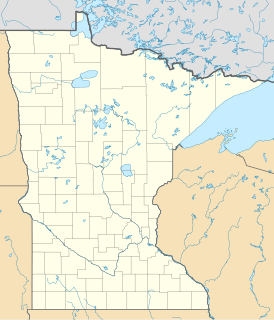Related Research Articles
The Willow River is a tributary of the Mississippi River, approximately 45 mi (72 km) long, in northern Minnesota in the United States.

The Kettle is an 83.6-mile-long (134.5 km) tributary of the St. Croix River in eastern Minnesota in the United States. Via the St. Croix River, it is part of the watershed of the Mississippi River. The river's English name is due to the large number of large rounded holes (kettles) in the sandstone in and around the river, carved out by the swirling waters of the river. The river's Dakota name Céġa watpa entered into English via the Anishinaabe people's Akiko-ziibi, both meaning "Kettle River".
The Dead Moose River is a 15.2-mile-long (24.5 km) tributary of the Kettle River in eastern Minnesota in the United States. Via the Kettle and St. Croix rivers, it is part of the watershed of the Mississippi River.
The Willow River is a 31.4-mile-long (50.5 km) tributary of the Kettle River in eastern Minnesota in the United States. It is one of three rivers by that name in Minnesota. Via the Kettle and St. Croix rivers, it is part of the watershed of the Mississippi River.
The Willard Munger State Trail is a system of recreational trails between Hinckley, Minnesota and Duluth, Minnesota. There are three segments to the trail, Hinckley to Duluth Segment, Alex Laveau Memorial Trail, and Matthew Lourey State Trail.
The Castor and Pollux River is located in Nunavut, Canada about 80 kilometres (50 mi) northeast of Chantry Inlet. In 1839 it was reached from the west by Thomas Simpson and Peter Warren Dease who named it after their two boats. At this point the entire north coast of North America had been roughly mapped from the Bering Strait to the Castor and Pollox River. In 1854 it was reached from the east by John Rae (explorer), thereby closing the last gap in the line from Bering Strait to Hudson Bay.
The Deer River is a river of Minnesota. It is a tributary of the Mississippi River.
The Hill River is a river of Minnesota. It is a tributary of the Willow River.
The Little Tamarack River is a tributary of the Tamarack River of Minnesota in the United States. After flowing into the Tamarack River, it flows into the Prairie River and then into the Big Sandy Lake.
The Little Willow River is a 26.2-mile-long (42.2 km) tributary of the Mississippi River in northern Minnesota, United States. It rises in western Aitkin County at the outlet of Esquagamah Lake and flows generally south to its junction with the Mississippi River 3 miles (5 km) northwest of Aitkin.
The Moose Horn River is a 36.4-mile-long (58.6 km) tributary of the Kettle River in eastern Minnesota, United States. It is part of the St. Croix River watershed, flowing eventually to the Mississippi River. It rises at the outlet of Wild River Lake, 7 miles (11 km) southwest of the city of Cloquet, and flows southwest through Carlton County, roughly parallel to Interstate 35. The river passes the communities of Mahtowa, Barnum, and Moose Lake, ending at the Kettle River southwest of the city of Sturgeon Lake.
The Moose River is a river of Minnesota. It is a tributary of the Nina Moose River.
The Portage River is an 8.8-mile-long (14.2 km) tributary of the Moose Horn River in eastern Minnesota, United States. It flows west to the Moose Horn River, joining it at Moosehead Lake next to the city of Moose Lake. By the Moose Horn River, its waters flow to the Kettle River, St. Croix River, and ultimately the Mississippi River. Just to the east of the Portage River, Nemadji Creek flows east to the Nemadji River, a tributary of Lake Superior and part of the Saint Lawrence River basin.
The Portage River is a river of Minnesota. It is a tributary of the Nina Moose River.
The Rice River is a 57.1-mile-long (91.9 km) tributary of the Mississippi River in northern Minnesota, United States. It rises in southeastern Aitkin County at the outlet of Porcupine Lake and flows generally north into Rice Lake National Wildlife Refuge, where it turns west and flows to the Mississippi 5 miles (8 km) northeast of Aitkin.
The Sandy River is a river of Minnesota. It is a tributary of the Mississippi River.
The West Branch Moose River is a short tributary of the South Branch Moose River in Franklin County, Maine. Its source is on Caribou Mountain in Merrill Strip, about 2,000 feet (600 m) from the Canada–United States border, which runs along the height of land between the watersheds of the Kennebec River in Maine and the Chaudière River in Quebec. From there, the river runs 5.9 miles (9.5 km) northeast to its confluence with the Moose River's South Branch in Skinner.
The Minnesota Correctional Facility – Willow River/Moose Lake is a two-site prison operated by the Minnesota Department of Corrections in Pine and Carlton counties.

Haypoint is an unincorporated community in Macville Township, Aitkin County, Minnesota, United States, within the Hill River State Forest. The community is located along U.S. Highway 169 near the junction with Aitkin County Road 7, 610th Street. Nearby places include Hill City, Swatara, and Waukenabo. The Willow River, a tributary of the Mississippi River, flows through the community. The Moose River is also nearby.
References
- Minnesota Watersheds
- USGS Hydrologic Unit Map - State of Minnesota (1974)
Coordinates: 46°53′20″N93°33′21″W / 46.88889°N 93.55583°W
| This article related to a river or creek in Minnesota is a stub. You can help Wikipedia by expanding it. |